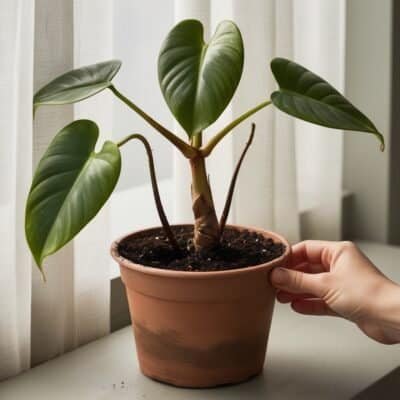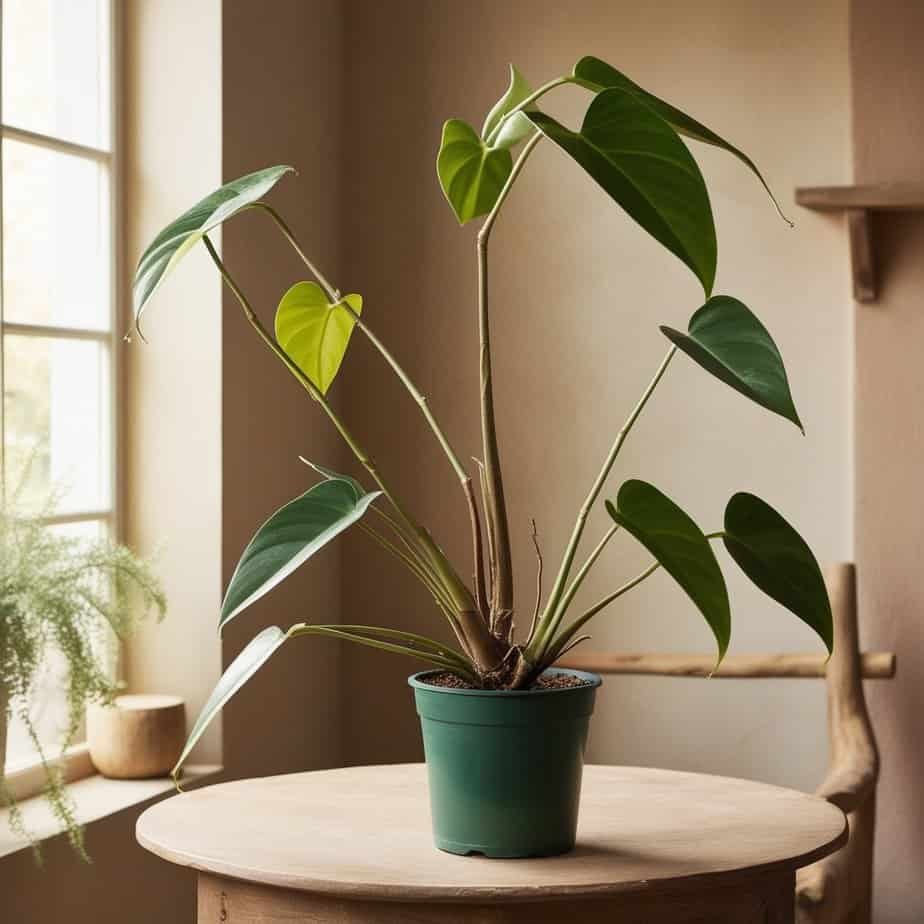Philodendrons are beloved houseplants known for their vibrant leaves and low maintenance. But over time, they can grow tall and thin between leaves. This “legginess” signals the plant isn’t receiving enough sunlight. As one expert explains, stems stretched several inches between foliage likely means it’s time for a change. Keep reading to discover simple ways to remedy leggy philodendrons and restore them to lush, leafy houseplants once more.
Key Takeaway
- Legginess in philodendrons usually means they need more light to thrive.
- Regular pruning can encourage healthier, bushier growth by removing long stems.
- Adjusting watering and fertilization correctly can help prevent leggy growth in the future.
Understanding Legginess in Philodendrons
Legginess is a common struggle for philodendron plants. When light is limited, they stretch upwards in search of more sun exposure. This results in elongated stems with sparse foliage between.
Philodendrons thrive on moderate indirect sunlight. They do best receiving four to six hours of filtered light daily. If placed in dim areas, legginess is likely to develop over time.
To keep philodendrons healthy, make sure they receive adequate lighting. Place plants near windows that provide diffused sunlight. If natural light is scarce, consider supplementing with grow lights. This extra illumination helps philodendrons grow in full and compact forms.
By learning what causes legginess, owners can take preventative steps. With some attentive care, philodendrons can maintain lush appearances for many years to come.
Signs of Insufficient Light
If your philodendron’s stems have become long and thin with small leaves spaced far apart, it may not be getting enough light. When plants don’t receive enough sunlight, they stretch taller to find more [1].
While stretching can help the plant survive, it doesn’t look very good. A healthy philodendron has thick stems packed close together with leaves.
If your plant looks stringy, try moving it to a brighter spot. Choose an area with bright, filtered sunlight throughout the day. You can also use grow lights at home if natural light is low.
Catching light issues early helps your plant look fuller again faster. Small changes like providing more sunlight can make a big difference to its appearance. With some extra light, your philodendron will bounce back looking lush and green!
Causes of Legginess
Insufficient light is usually the primary culprit behind leggy philodendron growth. Without adequate sunlight for photosynthesis, plants struggle and produce weak, elongated stems.
Overfertilization can also encourage legginess. Too much nitrogen especially leads to rapid but spindly development with long internodes.
Surrounding plant competition plays a role at times. If a philodendron doesn’t receive its fair share of light due to crowding, it will stretch upwards in search of sunnier areas.
Understanding these contributing factors allows owners to make small adjustments that benefit plant health. Improving light levels, moderating fertilizer amounts, and considering plant placement are simple ways to help philodendrons fill out with lush foliage. With a few tweaks, legginess can often be remedied and prevented.
Overwatering and Root Rot

Excess moisture can also lead to leggy philodendron growth. Constantly wet soil creates high humidity levels that weaken fragile stems. This makes the plant susceptible to challenges like root rot.
Root rot develops when roots are submerged too long, resulting in decay. If left unchecked, it can end a philodendron’s life.
To avoid overwatering mishaps, check the soil regularly. Water only when the top inch becomes dry. This allows roots to breathe while staying hydrated.
Proper watering is crucial for strong, compact growth. By ensuring the soil dries adequately between waterings, owners give their philodendron the best chance at lush foliage and sturdy stems. Small adjustments to watering habits can significantly benefit plant health and appearance.
Solutions to Fix Legginess
If your philodendron has become elongated and spindly, don’t despair – there are simple steps to restore its fullness.
Relocate the Plant
One simple way to revitalize a leggy philodendron is by moving it to a sunnier spot. Locations with indirect, bright windows are ideal. Filtered sunlight suits these plants well [2].
If natural lighting remains limited, supplementing with grow lights provides the perfect spectrum. This is especially useful in dimmer rooms indoors.
When relocating, go gradually to prevent stress. Slow acclimation allows adjustment to the new environment.
Adequate illumination spurs robust growth. Strong stems and lush foliage result. With improved light, your philodendron’s attractive appearance will shine once more. Small adjustments here make a big difference in supporting the plant’s health and beauty.
Pruning for Health
Pruning is an effective way to revitalize leggy philodendron growth. By trimming elongated stems with clean, sharp scissors or pruners, the plant can focus energy on developing compact new foliage.
Take care to only prune off a small portion at a time—no more than half the plant. Excessive cutting can stress it. Gradual trims over a few weeks allow adjustment.
When pruning, cut just above a leaf node. Nodes are bumps where leaves sprout, so this technique promotes bushy regrowth. It gives the philodendron a fuller appearance.
Be sure to keep conditions ideal for recovery. Provide ample bright, indirect light and monitor soil moisture. With some attentive care post-pruning, the philodendron’s lush appearance will return stronger than before. This is a simple solution worth trying for leggy specimens.
Adjust Fertilization
It’s important for leggy philodendron health to avoid over-fertilizing. Too much nutrient input can promote spindly growth.
A well-balanced monthly feeding generally suffices. Look for all-purpose formulas containing equal parts nitrogen, phosphorus and potassium. This encourages robust foliage.
Take care when applying. If growth seems excessively quick or leggy, scale back amounts. This signals potential nutrient excess.
Be sure to follow package directions carefully. Proper fertilizing provides philodendrons what they need to look their lush best, without risking imbalances that compromise form. Some small adjustments can make a big difference for your plant’s welfare.
Monitoring Watering Practices
Managing moisture levels is crucial, as overwatering risks leggy growth and yellowing leaves. Too much water can deprive roots of oxygen and lead to rot.
To keep your plant hydrated without harm, water only when the topsoil becomes dry to the touch. Stick a finger in to check moisture levels below surface.
When watering time arrives, be sure the soil is thoroughly saturated. Allow excess to drain fully from the drainage holes. This prevents roots from sitting in wetness while still replenishing what they need.
By monitoring moisture with regular checks, you can ensure your philodendron thrives. Proper watering habits support lush foliage and sturdy stems that enhance any space. Small adjustments here go far in supporting plant welfare and beauty.
Encouraging Bushier Growth
To promote fuller foliage, try grouping young philodendron plants together. Crowding encourages branching as they interact. This lush, clustered style enhances any space.
Regular pruning is also effective. Trim the main stem just above a leaf node, the bump where new growth emerges. This stimulates bushy regrowth.
Take care not to prune too severely at once, as excessive cutting can shock the plant. Gradual trims done over weeks allow it to adjust.
New leaves will fill in gaps between nodes. Over time, a bushier form develops. Regular care ensures it remains vibrant and attractive for years to come. Simple steps nourish a compact growth habit ideal for indoor spaces. With a little effort, an impressive display can be had from this versatile houseplant.
FAQ
Why is my philodendron leggy and how can I fix it?
Leggy philodendron plants often result from insufficient light. To fix this, move your plant to a brighter spot with indirect sunlight. If natural light is limited, consider using grow lights. Prune leggy stems to encourage new growth and create a bushier appearance. Regular pruning, along with proper light and care, will promote healthier growth and prevent your philodendron from becoming leggy again.
How does light affect philodendron growth?
Philodendrons thrive in bright indirect light. Low light conditions can cause leggy growth as the plant stretches towards light sources. If your living room doesn’t provide enough natural light, consider using grow lights to supplement. Be cautious with direct sunlight, as it can scorch philodendron leaves. Proper lighting is crucial during the growing season to maintain compact, healthy growth.
What are some easy ways to care for leggy houseplants like philodendrons?
To care for leggy philodendrons, start by assessing light conditions. Move your plant to a brighter spot or add grow lights. Prune long stems to encourage bushier growth. Use a well-draining potting mix to prevent root rot. Maintain proper humidity levels, as philodendrons are tropical plants. Regular care, including proper watering and occasional fertilizing, will help prevent leggy growth and keep your indoor plant thriving.
How do I prune my leggy philodendron?
Prune your leggy philodendron by cutting back long stems just above a leaf node. This encourages new growth and creates a fuller plant. For heart leaf philodendrons with leggy vines, you can cut them back significantly – they’re resilient plants. Use clean, sharp scissors to avoid damaging the plant. Consider propagating the cuttings to create new plants or fill out the mother plant for a bushier appearance.
What causes yellow leaves on my philodendron?
Philodendron leaves turning yellow can be caused by several factors. Overwatering is a common culprit, leading to root rot. Conversely, underwatering can also cause yellowing. Check the soil level and adjust your watering routine. Insufficient light might cause lower leaves to turn yellow and drop. Nutrient deficiencies, particularly during the growing season, can also result in yellowing leaves. Address these issues to maintain healthy, green foliage.
How can I encourage new growth on my leggy philodendron?
To encourage new growth on a leggy philodendron, start by providing bright indirect light. Prune leggy stems to stimulate branching. Use a balanced fertilizer during the growing season to support healthy growth. Ensure proper humidity levels, as philodendrons love moisture. Regular pruning and pinching of growing tips will promote bushier growth. With consistent care, your philodendron will develop fuller, more attractive foliage.
What’s the difference between a leggy philodendron and a monstera deliciosa?
While both are popular indoor plants, philodendrons and monstera deliciosa have distinct characteristics. Philodendrons typically have heart-shaped leaves and can become leggy in low light. Monstera deliciosa, known for its large, split leaves, is generally a larger plant. Both can develop leggy growth in insufficient light, but their care needs and appearance differ. Proper identification helps in providing the right care to prevent legginess in either plant.
Conclusion
Leggy philodendrons often need adjustments to bounce back. Provide more bright, indirect sunlight near a window. Prune stems regularly above leaf nodes to stimulate bushy regrowth. Carefully monitor soil moisture and only water when the top inch is dry. Limit fertilizer to prevent imbalance. With these simple changes, your philodendron will regain its lush appearance quickly.
References
- https://gardenswhisper.com/how-to-fix-a-leggy-philodendron/
- https://plantpursuits.com/why-is-my-philodendron-leggy/
Related Articles
- https://knowngarden.com/leggy-philodendron/
- https://knowngarden.com/leggy-jade-plant/
- https://knowngarden.com/fantastic-tips-for-pruning-jade-plant/

